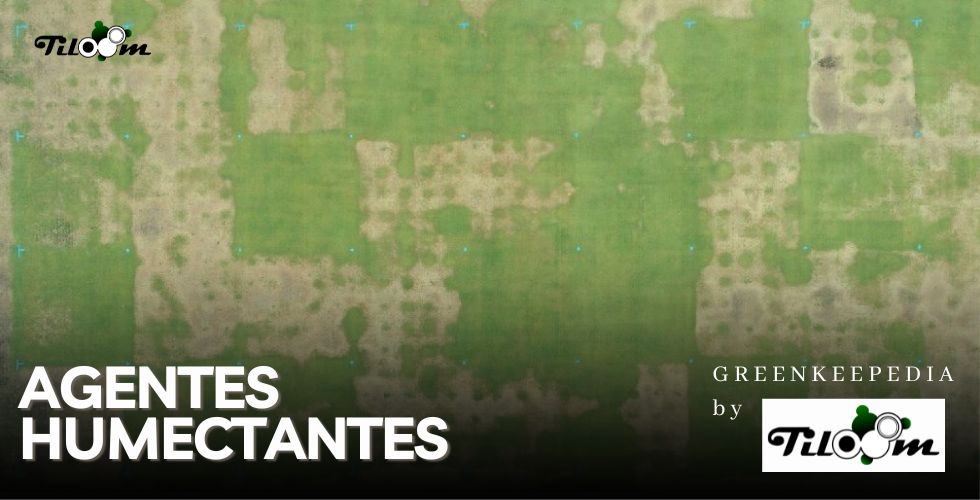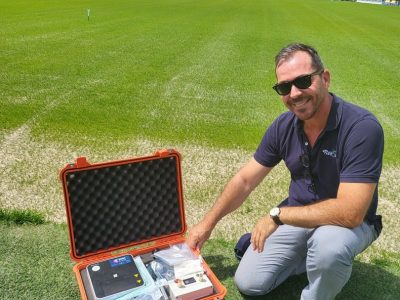On golf courses, especially on sand-based growing substrates such as USGA greens, soil water repellency is, unfortunately, an unavoidable condition. Although soil water repellency can occur in all soil types, coarser particles, such as sands used to construct and/or cover greens, are more susceptible to the development of water repellency because they have a significantly lower specific surface area (>105 times) (area/mass) compared to peat and clay.
What are wetting agents?
Wetting agents are essentially surfactants, a type of molecule with a hydrophilic and a hydrophobic end. They generally reduce the surface tension of water and ensure that water penetrates through the soil. This prevents dry patches from developing in periods of drought and improves water movement during heavy rainfall.
What is hydrophobicity and how to reduce it?
Water repellency, or hydrophobicity, is a phenomenon in which a surface repels water in individual droplets, thus inhibiting water infiltration into porous media such as soil. This repellent force is caused by a strong cohesion within the body of water, which is called "surface tension" or "surface free energy".
Under normal conditions (68 F; 20 C), the surface tension of water is 72.75 millinewtons/meter. Surfaces with a surface free energy greater than 72.75 millinewtons/meter have stronger adhesive forces than the cohesive force within water, which forces attraction with the water molecules in contact and spreads them over the surfaces, sequentially retaining water and forming hydrophilic surfaces.
When a soil medium becomes hydrophobic due to an accumulation of organic acids, its surface free energy decreases to less than 72.75 millinewton/meter, resulting in a failed attraction to avoid water molecules and, inevitably, the development of water repellency. The addition of wetting agents (amphiphilic molecules with hydrophobic tails and hydrophilic heads in their chemical structures) reduces the surface tension of water and simultaneously allows the wetting agents to pass into the soil, thereby increasing infiltration and water retention.
A study conducted at the University of Arkansas in 2021 tested several wetting agents. Multifunctional wetting agents proved to be more effective even at lower application rates compared to vertical wetting agents.
Influence of water:
Water quality is an essential aspect to consider in turfgrass management. Factors such as salt content, pH and the presence of various ions can greatly affect turfgrass health. However, it is important to note that these conditions do not directly affect how wetting agents address soil hydrophobicity. While soil amendments may be required to manage water quality issues, they will not normally affect the functionality of wetting agents.
Influence of turf:
While it may appear that wetting agents behave differently on different turf types, the reality is a little more complex. Wetting agents are more indirectly affected by turf type because different turf species can have different impacts on the soil. Factors such as the amount of organic matter a grass species produces, the exudates from its roots, the depth of its roots and even its drought tolerance can influence the water repellency of the soil, which in turn can affect the effectiveness of wetting agents.
Benefits of using wetting agents:
- Optimises water use efficiency.
- Improves soil and turf moisture retention.
- Reduces water stress
- Minimise water use and runoff
- Promotes deeper root growth.
- Healthier and more resilient turf
You can use biological surfactants such as EVRused in large sectors of agriculture, which contains saponins from Yucca schidigeranative to Baja California, Mexico. This plant contains a very high content of saponins (minimum 10%) which the plant uses to protect itself from the most extreme desert stress conditions.
The saponins present in Yucca schidigera reduce the surface tension of water and ensure that water penetrates more effectively to the roots. As a result, water and nutrients are more readily available to the root, improving plant development.
You can also try TRY NUTRY WET. This is a moisturiser based on non-ionic surfactantswhich are non-phytotoxic, reduce the surface tension of water, making it easier to wet and improving water retention. infiltration of soils, also incorporating Mn and Zn in its composition.
Contact us through info@tiloom.com for a personalised quotation.












